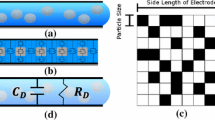Abstract
We demonstrate the use of heat to count microscopic particles. A thermal particle detector (TPD) was fabricated by combining a 500-nm-thick silicon nitride membrane containing a thin-film resistive temperature detector with a silicone elastomer microchannel. Particles with diameters of 90 and 200 μm created relative temperature changes of 0.11 and −0.44 K, respectively, as they flowed by the sensor. A first-order lumped thermal model was developed to predict the temperature changes. Multiple particles were counted in series to demonstrate the utility of the TPD as a particle counter.







Similar content being viewed by others
References
Duffy DC, McDonald JC, Schueller OJA, Whitesides GM (1998) Rapid prototyping of microfluidic systems in poly(dimethylsiloxane). Anal Chem 70(23):4974–4984
Incropera FP, DeWitt DP (1996) Fundamentals of heat and mass transfer, 4th edn. Wiley, New York
Janes MR, Rommel C (2011) Next-generation flow cytometry. Nat Biotechnol 29(7):602–604
Jin JS, Lee JS, Kwon O (2008) Electron effective mean free path and thermal conductivity predictions of metallic thin films. Appl Phys Lett 92(17):171910
Karayacoubian P, Bahrami M, Culham JR (2005) Asymptotic solutions of effective thermal conductivity. In: Proceedings of IMECE 2005. ASME international mechanical engineering congress and exposition. Orlando, Florida, USA, IMECE2005-82734
Lacy F (2011) Evaluating the resistivity-temperature relationship for RTDs and other conductors. IEEE Sens J 11(5):1208–1213
Lee J, Spadaccini C, Mukerjee E, King W (2008) Differential scanning calorimeter based on suspended membrane single crystal silicon microhotplate. J Microelectromech Syst 17(6):1513–1525
Leonard WF, Ramey RL (1966) Temperature coefficient of resistance in thin metal films. J Appl Phys 37(9):3634–3635
Murali S, Jagtiani AV, Xia X, Carletta J, Zhe J (2009) A microfluidic coulter counting device for metal wear detection in lubrication oil. Rev Sci Instrum 80(1):016105
Shardt O, Mitra SK, Derksen J (2012) Lattice boltzmann simulations of pinched flow fractionation. Chem Eng Sci 75(0):106–119
van der Wiel A, Linder C, de Rooij N, Bezinge A (1993) A liquid velocity sensor based on the hot-wire principle. Sens Actuators A Phys 37(38(0):693–697
Yi N, Park BK, Kim D, Park J (2011) Micro-droplet detection and characterization using thermal responses. Lab Chip 11:2378–2384
Zhang H, Chon C, Pan X, Li D (2009) Methods for counting particles in microfluidic applications. Microfluid Nanofluid 7(6):739–749
Acknowledgments
We thank Clement Kleinstreuer and John Sader for helpful discussions.
Author information
Authors and Affiliations
Corresponding author
Rights and permissions
About this article
Cite this article
Vutha, A., Davaji, B., Lee, C.H. et al. A microfluidic device for thermal particle detection. Microfluid Nanofluid 17, 871–878 (2014). https://doi.org/10.1007/s10404-014-1369-z
Received:
Accepted:
Published:
Issue Date:
DOI: https://doi.org/10.1007/s10404-014-1369-z




